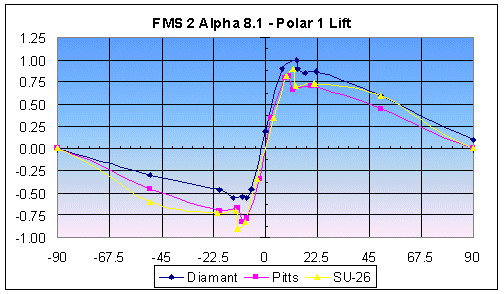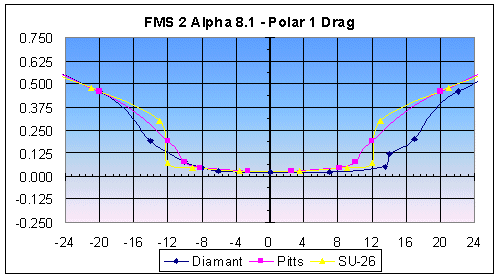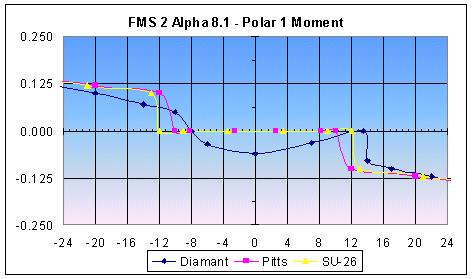Discussion of FMS 2 Alpha 8 POLAR
by Gary Gunnerson
FMS Home
Page
FMS
Forum
www.rc-sim.de Forum
RC Groups
Sim Forum
Other FMS Links
The POLAR sections of the FMS 2 Alpha 8
.par file describe lift, drag and moment coefficients of surfaces (Flächen) at
different angles of attack from -180 degrees to +180 degrees.
Usually, but not always, there will be 3 POLAR. The first is
for the main lifting wings, the second is usually used for control surfaces
(rudder/elevator) and the third describes the flight characteristics of the
fuselage.
With the models included in the download of FMS 2 Alpha 8.1,
we'll look at the POLAR values for the Diamant, Pitts and SU-26. The Transall
used duplicate POLAR values of another model so it is not discussed.
In addition, the Pitts only uses 2 POLAR -- one for wings,
rudder and elevator and another for the fuselage.
The LIFT components of the POLAR are virtually the same
beyond +/- 90 degrees so we'll include graphic plots of the lift component
within that range. The DRAG and MOMENT factors are the same from about +/- 20
degrees to +/- 180 degrees so we'll plot from -24 to +24 degrees for those
components.
You can find all the plots of the POLAR for these 3 planes
within an Excel spreadsheet on My
Webpage.
Main Wings POLAR
| LIFT: Note that all planes follow the same general plot lines for LIFT. The Diamant has higher lift when upright (i.e. positive AofA numbers) but less lift when inverted. This should be the same for high dihedral/polyhedral and less symmetric wings. |  |
| The Pitts and
SU-26 plots are very symmetrical indicating equal flight characteristics
both inverted and upright. It's interesting to see that the SU-26
increases lift between +/- 20 degrees and +/- 90 degrees angle of attack
with a lift data point at 50 degrees above the Pitts and equal with the
Diamant. You'll also see a reduction in lift right after the optimum angle of attack of the wing at 10, 12 and 14 degrees for the Pitts, SU-26 and Diamant respectively. This should relate in some way to the POLAR values of the airfoils used to create the wing. |
|
| DRAG:Note that the DRAG characteristics are very close to each other from 0 to +/- 8 degrees and above +/- 24 degrees so we'll be talking about a very narrow range of variance. |  |
|
Note that the Diamant DRAG is different when inverted with a smooth line
versus the spike in DRAG at 14 and 17 degrees. The Diamant DRAG in general
though is much smoother than the Pitts or SU-26 indicated a smoother less
draggy wing profile. The Pitts and SU-26 DRAG plots are symmetric as expected. You'll note that the DRAG for the Pitts starts sooner while the DRAG for the SU-26 has a very abrupt increase between 12 and 13 degrees angle of attack before settling back in with the others at about 20 degrees. |
|
| MOMENT: The MOMENT (torque by some definitions) also shows little variance beyond +/- 24 degrees angle of attack. |  |
| The plot of the DIAMANT MOMENT is fascinating as the coefficient goes negative from -8 to +13 degrees. We'll interpret this as a dampening of moment caused by wing dihedral/polyhedral. Note that the Pitts and SU-26 have equal data points from -11 to +11 angle of attack. Note that the MOMENT reductions happen at the same place as the optimum LIFT of 10, 12 and 14 degrees for Pitts, SU-26 and Diamant indicating the stall angle immediately following the most lift. | |
This concludes the discussion regarding the POLAR plots for the main wing of these 3 models included with the FMS 2 alpha 8.1 download. Next up as time permits will be a discussion of the DRAG and MOMENT plots for these planes. If you find any errors in this discussion, please email an update request to me at the address below.
THE END